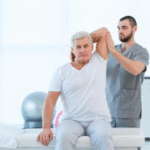Athletes with scoliosis do not stop moving — they adapt. A curved spine challenges balance, muscle control, and endurance. But many athletes learn how to move smarter, not harder. They grow stronger by working with therapists who understand spinal curves and the body’s natural patterns. Scoliosis physio helps athletes stay in shape by offering safe, targeted training that matches each person’s body.
Through focused care and smart routines, these athletes continue to run, swim, lift, and play. This article explores how they do it, where to find help, and why specific physiotherapy methods matter.
What Scoliosis Does to the Athletic Body?
Understanding the Spinal Curve
Scoliosis bends the spine into an “S” or “C” shape. This twist changes the way muscles pull and joints carry weight. The condition appears in children, teens, and adults. Some cases stay mild, while others require treatment to stop pain or damage.
Athletes with scoliosis may notice:
- One shoulder or hip sits higher than the other
- Movements feel uneven
- Certain drills tire one side more
- Their body leans or shifts in certain directions
These changes do not stop people from playing sports. But they do create risks when movement remains unbalanced.
Why Scoliosis Affects Sport Performance?
Many sports demand symmetry. Runners strike both feet. Swimmers pull with both arms. Lifters brace both sides of the spine. Scoliosis shifts this balance. The spine’s curve forces muscles to work harder on one side, while the other side weakens or stiffens.
Without proper training, these imbalances can cause:
- Fatigue after short workouts
- Poor technique
- Pain in the lower back, neck, or hips
- Uneven strength development
To prevent this, therapists craft training plans that match each curve type.
"Give thanks to the Lord for He is good: His love endures forever."
Targeted Physiotherapy as a Support System
What Makes Physio “Targeted”?
Not all physio works the same way. Generic programmes often miss the hidden movement habits scoliosis creates. Scoliosis physio begins by mapping how the spine moves during sport. The therapist studies how the athlete walks, bends, lifts, or lands from a jump. This deeper look guides safer training.
Next, they build exercises that:
- Strengthen weak core and back muscles
- Stretch tight, overworked areas
- Support joint control through full movements
This kind of care reduces pain and builds spinal support.
Active Work Over Passive Help
Unlike massage or machines, targeted physio asks the athlete to work. They use their own body to restore balance. Tools like foam rollers, resistance bands, or small weights help guide the movement. The goal is not to “fix” the spine but to train it for real life.
Athletes build skills that carry into their sports. They become more aware of posture, weight shifts, and muscle activation.
Sports-Specific Adjustments for Different Movements
Each sport uses the spine in its way. Therapists adjust plans depending on which muscles get used most. For example, rowers may need more hip alignment drills. Dancers may train spinal extension control.
Below is a table that highlights common scoliosis-related challenges and therapy approaches:
Sport-Specific Physio Adjustments
Sport
Common Challenge
Physiotherapy Focus
Running
Uneven stride or hip drop
Glute strength, gait retraining
Swimming
Shoulder asymmetry
Shoulder mobility, core rotation drills
Tennis
Overuse on one side
Cross-body balance, trunk stabilisation
Gymnastics
Hyperextension of the spine
Controlled flexibility, postural rebalancing
Weightlifting
Spinal compression or twist
Core strength, load alignment
Choosing the Right Physiotherapy Clinic in Singapore
Qualities to Look For
Athletes in Singapore have many options for care. Still, not every physiotherapy clinic Singapore specialises in scoliosis. A good clinic brings together trained physiotherapists who know how to manage spinal curves. They examine posture, understand athletic goals, and adjust sessions based on feedback.
The best clinics offer:
- Private space for movement drills
- Therapists with spine and sports experience
- Programmes that change as the athlete progresses
Look for clinics that explain each step and invite questions.
What to Avoid?
Avoid clinics that:
- Offer only passive treatments (e.g., massage only)
- Use the same exercises for every person
- Ignore sports-specific needs
The right clinic should empower athletes to manage their curve, not fear it.
Long-Term Management Through Smart Planning
Planning Training Cycles Around the Spine
Athletes must think in months and seasons, not just days. Therapists help shape training into safe cycles. This planning spreads effort across time and prevents overload.
A typical cycle includes:
- Movement correction in early stages
- Strength-building in mid-season
- Tapering or deload during peak sport times
This method protects the spine from repeated stress.
Building Body Awareness
Smart physio also teaches athletes how to feel early warning signs. They learn to spot changes in posture, tightness, or movement habits. With this awareness, they adjust before things worsen.
Therapists also train athletes to perform daily “check-in” moves. These light routines support posture and reduce soreness after workouts.
The Mental Side of Training With Scoliosis
Confidence in Movement
Scoliosis sometimes changes how athletes feel about their bodies. Uneven posture or discomfort may lower confidence. This can affect how they perform in front of others or during games.
Physiotherapy helps build trust in the body again. Small wins — like squatting deeper or balancing longer — bring back confidence. Therapists also explain that strength and symmetry do not always mean the same thing. The athlete learns to move with control, not just straightness.
Creating a Routine That Feels Safe
Consistency matters more than intensity. Physio becomes a habit, not a chore. Athletes feel better when they follow a routine they understand. They stretch, strengthen, and correct posture in 15–30 minutes a day. This daily rhythm often becomes part of warm-ups and cool-downs.
Therapists also suggest changes in sleeping positions, school bag use, or seated posture. These small shifts reduce stress on the spine through daily life.
Recovery Tools and Lifestyle Choices
How to Recover Like a Pro?
Recovery is part of training. Athletes with scoliosis need to recover with care. They use tools and routines that support the spine after hard sessions. These may include:
- Stretches that release tight back muscles
- Breathing drills that open the ribs
- Swimming or cycling on light days
Therapists often review recovery plans every few months to match changes in strength and sport demands.
Avoiding Injury by Listening to the Body
Every athlete should understand pain signals. Scoliosis physio teaches athletes to listen. If one side of the body works harder, soreness builds there. If posture shifts too far during sport, strain may appear.
By noticing these signs, athletes can act early. They stretch, pause, or adjust. This habit prevents missed games or long breaks from training.
Moving From Rehab to Performance
Linking Physio to Peak Training
Physio does not end when the pain stops. It becomes part of peak performance. Many athletes carry their therapy tools into the gym or field. Bands, sliders, or simple drills help keep the spine aligned before or after intense work.
When therapists and coaches work together, training grows safer and more effective. Coaches may include postural cues during practice. Therapists may visit training to see how movements change in real speed.
Staying Active for Life
Sports careers end. But movement does not. The habits built during scoliosis training carry into everyday life. Former athletes use the same principles to work at desks, drive cars, or carry children.
By learning body care early, they move with less fear and more control for years to come.
Conclusion
Athletes with scoliosis need not stop playing, training, or competing. They simply train with more focus. Scoliosis physio equips them to move safely, build strength, and understand their bodies. This path involves active care, clear plans, and strong partnerships with therapists.
For those living in Singapore, a skilled physiotherapy clinic Singapore helps guide this journey. With their support, athletes gain strength — not just in muscles, but in mindset. And when sports physiotherapy for scoliosis athletes follows each curve with care, it unlocks performance and protects the future.








